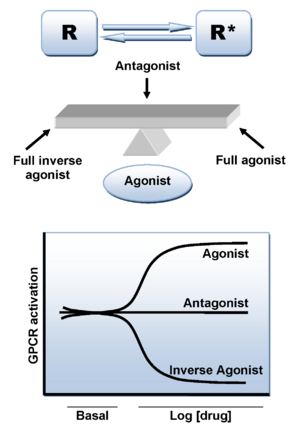Agonist: Difference between revisions
>Kaylee No edit summary |
>Kaylee No edit summary |
||
| Line 5: | Line 5: | ||
This contrasts the '''efficacy''' of a drug, which describes a drugs capacity to produce a response when bound to a receptor. A drug with high efficacy will produce a proportionally stronger effect than a drug of lower efficacy occupying the same number of receptors. The maximal efficacy of a drug reflects the greatest attainable response to a particular drug on a receptor set regardless of dose. A drug with a high efficacy may need to occupy less receptors to produce maximum effects, meaning it will not produce stronger effects beyond a certain dosage. | This contrasts the '''efficacy''' of a drug, which describes a drugs capacity to produce a response when bound to a receptor. A drug with high efficacy will produce a proportionally stronger effect than a drug of lower efficacy occupying the same number of receptors. The maximal efficacy of a drug reflects the greatest attainable response to a particular drug on a receptor set regardless of dose. A drug with a high efficacy may need to occupy less receptors to produce maximum effects, meaning it will not produce stronger effects beyond a certain dosage. | ||
In contrast, | In contrast, an [[antagonist]] is a chemical that binds to the receptor of a cell without causing a physiological response. Receptor antagonists block or reduce the effects produced by endogenous or drug induced agonism of a receptor. | ||
==Types of agonist== | ==Types of agonist== | ||
Revision as of 22:00, 17 April 2016

An agonist is a chemical that binds to the receptor of a cell and activates the receptor to cause a physiological response. An agonist initiates the same reaction typically produced by the binding of an endogenous ligand (such as a hormone or neurotransmitter) with a receptor. [1] A drug’s ability to affect a given receptor is dependent on the drug’s affinity and intrinsic efficacy towards that receptor. The affinity of a drug describes the strength of attraction between it and a given receptor, and consequently its ability to bind to that receptor. A drug with a high affinity for a receptor has a high likelihood of binding to it, while a drug with a low affinity has a lesser degree of attraction towards a receptor.
This contrasts the efficacy of a drug, which describes a drugs capacity to produce a response when bound to a receptor. A drug with high efficacy will produce a proportionally stronger effect than a drug of lower efficacy occupying the same number of receptors. The maximal efficacy of a drug reflects the greatest attainable response to a particular drug on a receptor set regardless of dose. A drug with a high efficacy may need to occupy less receptors to produce maximum effects, meaning it will not produce stronger effects beyond a certain dosage.
In contrast, an antagonist is a chemical that binds to the receptor of a cell without causing a physiological response. Receptor antagonists block or reduce the effects produced by endogenous or drug induced agonism of a receptor.
Types of agonist
Receptors can be activated by chemicals produced by the body (endogenous) or chemicals from outside of the body (exogenous). Therefore, an endogenous agonist for a particular receptor is a chemical produced in the body that binds to and activates that receptor.
Agonists
There are several types of agonist:
- A superagonist is an agonist that produces a greater response from the receptor than the endogenous agonist, and therefore has an efficacy of over 100%.
- A full agonist binds and activates a receptor, and has full efficacy at the receptor.
- A partial agonist binds and activates a receptor, but has only partial efficacy at the receptor.
Inverse agonists
An inverse agonist is an agent that binds to the same receptor binding-site as an agonist for that receptor, but reverses activity of receptors. Inverse agonists exert the opposite pharmacological effect of a receptor agonist.
Allosteric modulators
An allosteric modulator is a substance which indirectly influences (modulates) the effects of an agonist or inverse agonist at a target protein (for example a receptor). Allosteric modulators bind to a site distinct from that of the agonist binding site. Usually they induce a change within the protein structure. A positive allosteric modulator induces an amplification, while a negative modulator induces an attenuation of the effects of the ligand without triggering a functional activity on its own in the absence of the ligand.
See also
References
 |
This article does not cite enough references. You can help by adding some. |
http://www.merriam-webster.com/dictionary/agonist
- ↑ Agonist definition (Merriam-Webster) http://www.merriam-webster.com/dictionary/agonist